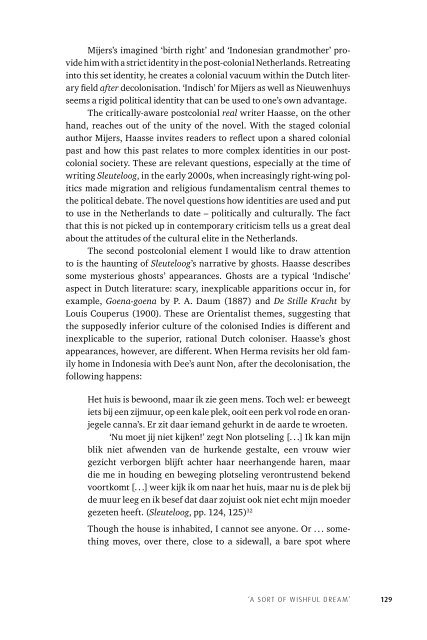Discord Consensus
7aze300jFJo
7aze300jFJo
You also want an ePaper? Increase the reach of your titles
YUMPU automatically turns print PDFs into web optimized ePapers that Google loves.
Mijers’s imagined ‘birth right’ and ‘Indonesian grandmother’ provide<br />
him with a strict identity in the post-colonial Netherlands. Retreating<br />
into this set identity, he creates a colonial vacuum within the Dutch literary<br />
field after decolonisation. ‘Indisch’ for Mijers as well as Nieuwenhuys<br />
seems a rigid political identity that can be used to one’s own advantage.<br />
The critically-aware postcolonial real writer Haasse, on the other<br />
hand, reaches out of the unity of the novel. With the staged colonial<br />
author Mijers, Haasse invites readers to reflect upon a shared colonial<br />
past and how this past relates to more complex identities in our post-<br />
colonial society. These are relevant questions, especially at the time of<br />
writing Sleuteloog, in the early 2000s, when increasingly right-wing politics<br />
made migration and religious fundamentalism central themes to<br />
the political debate. The novel questions how identities are used and put<br />
to use in the Netherlands to date –politically and culturally. The fact<br />
that this is not picked up in contemporary criticism tells us a great deal<br />
about the attitudes of the cultural elite in the Netherlands.<br />
The second postcolonial element I would like to draw attention<br />
to is the haunting of Sleuteloog’s narrative by ghosts. Haasse describes<br />
some mysterious ghosts’ appearances. Ghosts are a typical ‘Indische’<br />
aspect in Dutch literature: scary, inexplicable apparitions occur in, for<br />
example, Goena-goena by P. A. Daum (1887) and De Stille Kracht by<br />
Louis Couperus (1900). These are Orientalist themes, suggesting that<br />
the supposedly inferior culture of the colonised Indies is different and<br />
inexplicable to the superior, rational Dutch coloniser. Haasse’s ghost<br />
appearances, however, are different. When Herma revisits her old family<br />
home in Indonesia with Dee’s aunt Non, after the decolonisation, the<br />
following happens:<br />
Het huis is bewoond, maar ik zie geen mens. Toch wel: er beweegt<br />
iets bij een zijmuur, op een kale plek, ooit een perk vol rode en oranjegele<br />
canna’s. Er zit daar iemand gehurkt in de aarde te wroeten.<br />
‘Nu moet jij niet kijken!’ zegt Non plotseling [. . .] Ik kan mijn<br />
blik niet afwenden van de hurkende gestalte, een vrouw wier<br />
gezicht verborgen blijft achter haar neerhangende haren, maar<br />
die me in houding en beweging plotseling verontrustend bekend<br />
voortkomt [. . .] weer kijk ik om naar het huis, maar nu is de plek bij<br />
de muur leeg en ik besef dat daar zojuist ook niet echt mijn moeder<br />
gezeten heeft. (Sleuteloog, pp. 124, 125) 32<br />
Though the house is inhabited, I cannot see anyone. Or . . . something<br />
moves, over there, close to a sidewall, a bare spot where<br />
‘A sort of wishful dream’ 129


